|
Judge Isaac C. Parker
Isaac Charles Parker (October 15, 1838 – November 17, 1896) served
as a U.S. District Judge presiding over the U.S. District Court for the Western District of Arkansas for 21 years. He served
in that capacity during the most dangerous time for law enforcement during the western expansion. He is remembered today as
the legitimate "Hanging Judge" of the American Old West.
In 21 years on the bench, Judge Parker tried 13,490 cases, 344 of which
were capital crimes. Guilty pleas or convictions were handed down in 9,454 cases. Of the 160 (156 men and 4 women) sentenced
to death by hanging, 79 were actually hanged. The rest died in jail, appealed, or were pardoned.
Judge Isaac C. Parker, known as the "Hanging Judge," presided over the
court for 21 years.
| Judge Isaac C. Parker |
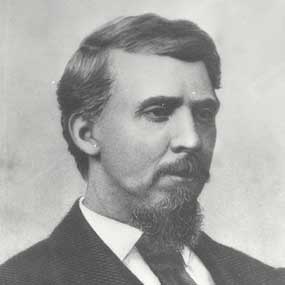
|
| "Hanging Judge" |
Remembered today simply as 'the Hanging Judge,' Isaac Parker grew up on
an Ohio farm, became a frontier attorney, and had a thirty-five year career in public service. He served as a city attorney,
state judge, two-term representative to Congress, and for twenty-one years was a federal district judge in Fort Smith.
"I am the most misunderstood and misrepresented of men. Misrepresented
because misunderstood."
-Judge Isaac C. Parker, 1896
For twenty-one years, Judge Isaac C. Parker held the bench of the U.S. Court
for the Western District of Arkansas. His tenure was unique in the history of the federal judiciary; while most U.S. district
judges toiled away on civil cases, Parker heard thousands of criminal complaints involving disputes and violence between Indians
and non-Indians. He sentenced 160 people to death, and for fourteen years he did so while the condemned had no right of appeal.
"I have ever had the single aim of justice in view... 'Do equal
and exact justice,' is my motto, and I have often said to the grand jury, 'Permit no innocent man to be punished, but let
no guilty man escape.'"
-Judge Isaac C. Parker, 1896
| "Hanging Judge" Parker |
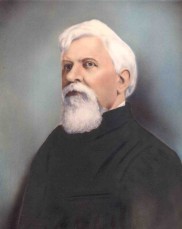
|
| (Painting) Judge Isaac Parker, circa 1896. |
| "Hanging Judge" Parker |
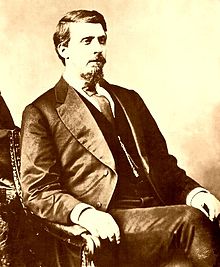
|
| (Photo) Missouri congressman Isaac Parker, 1874. |
Judge Parker, as a federal district judge, was appointed by the President,
and his authority was established by the Constitution.
| "Hanging Judge" Parker (c. 1890s) |
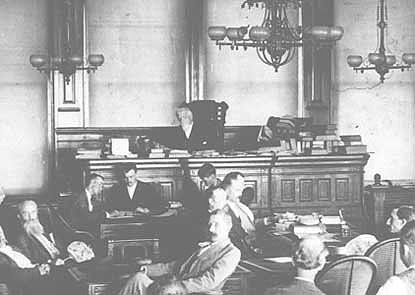
|
| Sixth Street Courthouse, Fort Smith, Arkansas |
The only known image of Judge Parker in his courtroom is this one from the
federal courthouse on Sixth Street which dates from the 1890s. There are no photographs of the courtroom located in the former
military barracks.
| "Hanging Judge" Parker's Gavel |
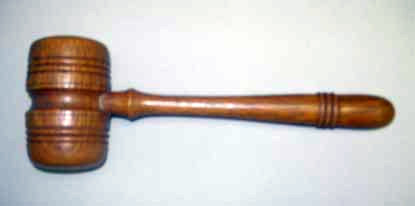
|
| Gavel used by Judge Parker (c. 1875-96) |
Wooden gavel used by Isaac C. Parker during his tenure as federal judge
for the Western District of Arkansas.
Judge Parker, Indian Territory, and Fort Smith: The Choctaw, Chickasaw,
Cherokee, Creek and Seminole Indian tribes were forcibly moved to Indian Territory on what became known as the Trail of Tears.
The Arkansas River served as a water route to Fort Smith where they received supplies before crossing the river into Indian
Territory. And Parker heard thousands of criminal complaints involving disputes and violence between Indians and non-Indians.
| Hanging Judge Isaac C. Parker |
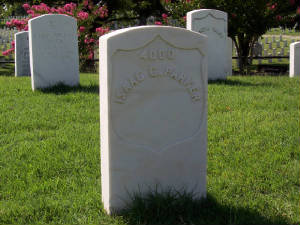
|
| (Photograph courtesy Matthew Parker) |
(Headstone of Hanging Judge Parker)
Fort Smith National Cemetery, one of only three "national
cemeteries" in Arkansas, is the final resting place for Judge Isaac C. Parker. The Hanging Judge doesn't even have a birth or death date inscription on his headstone.
Why? Judge Parker had requested this very plain headstone in hopes of remaining, and eventually fading, into the
background and shadows of a society that he had spent his entire life serving. In other words, Parker didn't want to
draw any more attention to himself.
Sensational cases and mass executions overshadowed Parker's contributions
in rehabilitating offenders, reforming the criminal justice system, and advocating the rights of the Indian nations. In Fort
Smith he tried to create, in his own words, "the moral force of a strong federal court."
Remembered in Western novels and films as a "Hanging Judge," Isaac Parker's
real career and accomplishments in Fort Smith are far more fascinating and complicated. The Hanging Judge, moreover, remains
one of the most famous judges in American history.
Sources: National Park Service; Fort Smith National Cemetery.
(Suggested reading at bottom of page)
Recommended Reading: Let No Guilty Man Escape: A Judicial Biography of "Hanging Judge" Isaac C. Parker (Legal
History of North America) (Hardcover). Description: Presiding from 1875 to 1896 over the
United States Court for the Western Judicial District
of Arkansas, Isaac Charles Parker attained notoriety as the "Hanging Judge" responsible for law and order in Indian
Territory. Popular accounts have portrayed him as a jurist driven relentlessly by a Biblical sense of justice
to administer absolute authority over a lawless jurisdiction inhabited by bold outlaws. Continued below…
"Let No Guilty Man Go Free", the
first new Parker biography in four decades, corrects this simplistic image by presenting Parker's unique brand of frontier
justice within the legal and political context of his time. Using primary documents from the National Archives, Missouri
court records, and other sources not included by previous biographers, Roger H. Tuller demonstrates that Parker was an ambitious
attorney who used the law to advance his own career. Parker rose from a frontier Missouri lawyer to become a congressional
representative, and when Reconstruction Era politics denied him continued progress, he sought the judicial appointment for
which he is most remembered. Although he sent seventy-nine felons to the gallows, Parker's public hangings were actually restricted
by federal officials, commutations, and pardons, as well as Supreme Court rulings. In an ironic twist, during his final public
interview, the "Hanging Judge" claimed he supported the abolition of the death penalty.
Recommended Reading: Isaac C. Parker: Federal Justice on the Frontier (The Oklahoma
Western Biographies, V. 20) (Hardcover). Description: The historical Isaac C. Parker (1838-1898) has been overshadowed by
his legend--the notorious "hanging judge" of the Wild West. In his time as district court judge, he did sentence over 160
people to execution, but Parker’s reputation as a bloodthirsty monster is unfounded. In reality, Parker assigned the
penalty mandated by law but had personal reservations about capital punishment. Continued below…
Born in Belmont County, Ohio,
Parker served as city attorney, circuit attorney, and circuit judge in Missouri
during the 1860s. He served in the U.S. House of Representatives from 1871 to 1875. However, his most famous tenure, from
1875 to 1896, was as judge of the U.S. District Court for the Western District of Arkansas and nearby Indian Territory (modern-day
Oklahoma). There, he quickly gained a reputation for swift,
stern justice. In 1889, the U.S. Congress allowed appeals from Parker’s court and reversed many of his convictions,
outraging Parker and furthering his reputation for dispensing angry, rough-hewn justice. Parker presided over civil cases
far more often than criminal cases. However, his jurisdiction included territory so lawless that several deputy U.S. marshals had to be appointed just to cover it. Of the
160 people Parker assigned the death penalty for murder or rape, 79 were actually executed. In this biography, Michael J.
Brodhead tells the life story of this man obscured by the sensationalism of his criminal court cases. Brodhead has based much
of his account on Parker’s published opinions and jury instructions, thereby allowing the judge’s own words and
rulings to testify on his behalf. Furthermore, this is the first book to consider Parker’s civil cases in any detail.
About the Author: Michael J. Brodhead, Professor Emeritus of History at the University
of Nevada, Reno, is a Historian in the Office of History,
U.S. Army Corps of Engineers, Alexandria, Virginia.
He is the author of "David J. Brewer: The Life of a Supreme Court Justice, 1837-1910" and co-editor and annotator of "A Naturalist
in Indian Territory: The Journals of S. W. Woodhouse, 1849-1850," also published by the University of Oklahoma Press.
Recommended Viewing: Hang 'em High (1968) (DVD), Starring: Clint Eastwood. Review: After starring in the now-legendary
trilogy of spaghetti Westerns for Italian director Sergio Leone, Clint Eastwood became a box-office star and imported the
style of those classic shoot-'em-ups for this 1967 Western directed by Ted Post, with whom Eastwood had worked during their
days on the television series Rawhide. Eastwood plays an innocent rancher who is mistaken for a cattle rustler and sentenced
to hang by an angry mob. Continued below…
When he is saved from the
noose by a passing lawman, he embarks on a renegade campaign of vengeance against the men who attempted to lynch him. Hang
'Em High offers a number of memorable moments and stylistic flourishes, and features a superb supporting cast of Western veterans,
including Ben Johnson, Ed Begley, Pat Hingle, Dennis Hopper, Bruce Dern, L.Q. Jones, and the "Skipper" himself, Alan Hale
Jr. Made just three years before Dirty Harry, the film marked a turning point for Eastwood, who would soon move into a prolific
period of contemporary thrillers. --Jeff Shannon. Product Description: They riddled him with bullets. They strung him up.
They left him to die. But they made two fatal mistakes: they hanged the wrong man...and they didn't finish the job. In his
first American-made western, Clint Eastwood indelibly carves his niche as the quintessential tough guy cool-headed, iron-willed
and unrelenting in his pursuit of revenge. Oklahoma, 1873. Jed Cooper (Eastwood), mistaken for a
rustler and killer, is lynched on the spot by crooked lawman Captain Wilson (Ed Begley) and a rampaging band of vigilantes.
But as Wilson and his gang flee the scene, there's one very important detail they've overlooked: Cooper is still alive! Out
for justice and vengeance, Cooper takes on the job of deputy marshal...and, one by one, tracks down the nine men who "done
him wrong."
Recommended Reading: Encyclopedia Of Western Lawmen and Outlaws. Description: With more than 1,000 entries
and more than 400 pictures it would be hard to complain about this encyclopedia. The Edgar Award-winning author of the unparalleled
Encyclopedia of World Crime turns his authoritative eye to the American West in this vast catalog of the outlaws of the new
frontier and the courageous lawmen who faced them. Continued below...
The entries include Billy the Kid, Frank and Jesse James, Butch Cassidy, Wyatt Earp, Bat Masterson,
"Wild Bill" Hickok, Judge Roy Bean, the Youngers, Belle Starr, Poker Alice Ivers, and others. More than 300 photographs
and illustrations.
Recommended Reading:
Wyatt Earp: The Life Behind the Legend. Description: From Kirkus Reviews:
This biography of the controversial western lawman, by a former San Francisco Examiner writer, uses newly found primary sources
and exhaustive archival research to uncover the real man obscured by myths, tall tales, and calumnies. Tefertiller's version
of Earp finds, amid some unpleasant elements, a real core of heroism. He had a penchant for gambling and saloon life, was
an energetic womanizer, and had a habit of applying undue force in arresting suspects. Yet he was also, as Tefertiller documents,
indisputably courageous. Continued below…
His varied and colorful
career included time as a security guard on Wells Fargo stagecoaches, prospecting, running faro games, and speculating on
western lands and mines. Most famously, though, he served as a town sheriff and a US marshal. That Earp could be at various
times a gambler and a marshal should not, the author suggests, seem all that startling: Gamblers were highly esteemed figures
in the demimonde of the wide open towns of the frontier. Men familiar with violence seemed to these communities to be the
ideal choice to establish order. During his term as marshal of Tombstone, Ariz., Earp did just that, confronting rustlers,
robbers, and gunmen, bringing them to justice or occasionally shooting it out with them, most famously in the gunfight at
the O.K. Corral. Earp's actions inevitably brought him into conflict with powerful, autocratic ranchers and corrupt politicians.
The charges that blackened Earp's reputation, Tefertiller argues, were largely fictions circulated by his enemies, who planted
stories about him in pliant frontier newspapers. Using a wide variety of primary sources, Tefertiller manages to summon up
a human, complex figure and, while not omitting flaws, to persuasively demonstrate that Earp believed in the law and did his
best in hard times to defend it. A great adventure story and solid history. (42 photos, not seen) -- Copyright ©1997, Kirkus
Associates, LP. All rights reserved.
Recommended Reading:
The Encyclopedia of Lawmen, Outlaws, and Gunfighters (Facts on File Crime
Library) (Hardcover). Description: Standoffs, saloons and sunsets spring to mind when one envisions the rough and tumble of
the early days of the American frontier. Indeed, the golden period of the American West produced some of the most notorious
badmen and bravest lawmen in American history, many of whom have become legends. Some rogues are familiar: John Wesley Hardin
(who, it is said, killed more than 40 men), William Bonney (Billy the Kid), Wild Bill Hickok, and Butch Cassidy and the Sundance
Kid. Continued below…
Others are not so well known but
were no less dangerous: John Slaughter, Buckskin Frank Leslie, Wild Bill Longely, Liver-Eating Johnson, and Bill Doolin. Then
there are the peacekeepers, the brave men who helped tame the Wild West: the Earp Brothers, Pat Garrett, and Texas Rangers
such as James Gillett and Dallas Stoudenmire. This encyclopedia features more than 400 entries, providing comprehensive biographies
of men and women, from both sides of the law, who made their mark on the American frontier. Topics covered also include legendary
incidents like the shootout at the OK Corral and the Johnson County War, as well as subjects that marked the era such as dime
novels, faro, and quick-draw artists. This collection seeks to separate fact from fiction, offering reference material for
fans of the Old West. About the Author: Leon C. Metz is a critically acclaimed author and expert on the Old West. He is the
author of sixteen nonfiction books, including Pat Garrett: Story of a Western Lawman and The Shooters: A Gallery of Notorious
Gunmen from the American West. He has appeared on The Learning Channel's series Gunfighters of the Old West and will be included
in a forthcoming documentary of the Old West to be broadcast on The History Channel. Mr. Metz lives in El Paso, TX.
Additional reading; many of these outstanding works may be located via the Amazon.com search box.
BIOGRAPHIES AND HISTORY BOOKS
These are works by professional
historians and other scholars that cover the judge and his time at Fort Smith in a fully documented and well-researched fashion.
Burton, Jeffrey. Indian Territory
and the United States, 1866-1906: Courts, Government, and the Movement
for Oklahoma Statehood. Norman:
University of Oklahoma
Press, 1995.
Harman, S.W. Hell on the
Border: He Hanged Eighty-Eight Men. Fort Smith: Phoenix, 1898;
reprint, Lincoln: University
of Nebraska Press, 1992.
Harring, Sidney L. Crow
Dog's Case: American Indian Sovereignty, Tribal Law and United
States Law in the 19th Century.
New York: Cambridge University Press, 1984.
Harrington, Fred Harvey. Hanging
Judge. Caldwell, Idaho: Caxton, 1952; reprint, Norman:
University of Oklahoma Press,
1996.
Tuller, Roger. "'Let No
Guilty Man Escape': A Judicial Biography of Isaac C. Parker." Norman, OK:
University of Oklahoma
Press, 2001.
GENERAL WORKS
These are non-scholarly works
written for a general audience. Some of the works written in the 1950s contain errors and misinformation.
Croy, Homer. He Hanged Them
High: An Authentic Account of the Fanatical Judge Who Hanged Eighty-Eight Men. Duell, Sloan & Pearce, Inc.--Little, Brown
& Co., New York and Boston,
1952.
Emery, J. Gladstone. Court
of the Damned: Being a Factual Story of the Court of Judge Isaac C. Parker and the Life and Times of the Indian Territory
and Old Fort Smith. New
York: Comet Press Books, 1959.
Galonksa, Julie, and Eric
Leonard. "In His Own Words: Quotations of Judge Isaac C. Parker," Fort Washington,
PA: Eastern National, 2001.
Nichols, Guy, Leo Allison
and Thomas Crowson. "Judge Isaac C. Parker: Myths and Legends Aside." Washington,
D.C.: National Park Service, nd.
Shirley, Glenn. Law West of Fort Smith: A History of Frontier Justice in the Indian Territory, 1834-1896.
Lincoln: University of Nebraska Press, 1957.
FICTION
These are works that address
the world in which Judge Parker lived in a fictional fashion.
Hamilton, Bruce. Hanging
Judge. New York: Harper, 1948.
Jones, Douglas C. Winding
Stair. New York : Holt, Rinehart, and Winston, 1979.
Kelton, Elmer. Hanging Judge.
Thorndike, ME: G.K. Hall,
1969.
McMurtry, Larry and Diana
Ossana. Zeke and Ned. New York: Simon and Schuster, 1997.
Moore,
Lonnie W. Gates of Hell: The Wrath of Judge Isaac Parker. Oroville, CA: L.W. Moore, 1998.
Portis, Charles. True Grit.
New York, Simon and Schuster, 1968.
Stanley, Mack. Hanging Judge
and his Desperadoes. Spiro, OK:
Mack Stanley, 1983.
Thompson, J.M and Fred Bean.
Hell on the Border. New York: Signet, 2002.
West, Joseph A. Johnny Blue
and the Hanging Judge. New York: Signet, 2001.
ARTICLES
Articles published in a
wide variety of media, including historical journals and old west magazines.
Daily, Harry P. "Judge Isaac
C. Parker," Chronicles of Oklahoma, XI (March 1933): 673-89.
Dawson, Robert T. "Judge
Parker and the Allen Rule." The Journal (Fort Smith Historical
Society) (April 1997): 5-6.
Dobbs, G. Byron. "A Lawyer's
Appraisal of the Parker Court." The Parapet (Fort Smith, Arkansas, Junior League)
February 1969: 6-9.
_____. "Murder in the Supreme
Court: Appeals from the Hanging Judge." Arkansas Law Review,
XXIX: 47.
Fitzjarrald, Sarah. "Judge
Isaac C. Parker 'On Trial.'" The Journal (Fort Smith Historical
Society) (April 1988): 14-20.
_____. "Judge Parker Must
Have Led a Charmed Life." The Journal (Fort Smith Historical
Society) (September 1993): 43-44.
Harrington, Fred Harvey.
"Hanging Judge Parker: The Man and Not the Myth." Arkansas
Historical Quarterly, V (Spring 1946): 63-77.
Kidder, Bradley W. "Goodbye,
Tall Old Oak." The White River Valley Historical Quarterly
(Summer
1998): 3-11.
Miller, John E. "Isaac Charles
Parker." Arkansas Historical Quarterly, 31 (1972): 54-57.
Parker, Isaac Charles. "How
to Arrest the Increase of Homicides in America."
North American Review, (June 1896): 667-673.
Rehnquist, William H. "Isaac
Parker, Bill Sikes and the Rule of Law." University of Arkansas
at Little Rock Law Journal (1983): 485-499.
Semple, William F. "Isaac
C. Parker, Judge of the United States Court," The
Journal (publication of the Oklahoma Bar Association), 22 (August 25, 1951).
Stolberg, Mary M. "The Evolution of Frontier Justice: The Case of Judge Isaac C. Parker."
Prologue, (Spring 1988): 7-23.
_____. "Politician, Populist,
Reformer: A Reexamination of "Hanging Judge" Isaac C. Parker." Arkansas
Historical Quarterly, LXVII (Spring 1988): 3-28.
Tuller, Roger. "Bigamy in
the Indian Territory, 1878-1890." West Texas Historical
Association Yearbook, LXVII (1992): 100-112.
OTHER WORKS
An often overlooked category
of material includes research papers and theses written on the judge.
Hadley, Roger Henderson.
"Isaac C. Parker: The Speeches and the Image." Unpublished Thesis, University
of Oklahoma, 1971.
Kidder, Bradley W. "Who
Took the Trees? A Review of Timber Trespass Litigation in the Federal Court for the Western District of Arkansas Under the Administration of Judge Isaac C. Parker,
1875-1896." Unpublished
Thesis, University of Arkansas, Fayetteville, Arkansas, 1996.
Murphy, James O. "The Work of Judge Parker in the United States
District Court for the Western District of Arkansas--1875-1896."
Unpublished Thesis, University of Oklahoma,
Norman, Oklahoma, 1939.
Stolberg, Mary M. "Politician, Populist, Reformer: A Reexamination of Hanging Judge Isaac
Parker." Unpublished Thesis, University of Virginia,
Richmond, Virginia, 1986.
Tuller, Roger. "'The Hanging
Judge' and the Indians: Isaac C. Parker and U.S.
Indian Policy, 1871- 1896." Unpublished Thesis, Texas Christian
University, Fort Worth, Texas, 1993.
_____. "'Let No Guilty Man
Escape': A Judicial Biography of Isaac C. Parker." Unpublished
Dissertation, Texas
Christian University, Fort Worth, Texas, 1996
|

